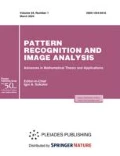Abstract
For long-term pulse tracking, it is possible to use the photoplethysmography method, the essence of which is estimating the dynamics of optical properties of examined organ tissues. Since this method is not invasive and does not need complicated equipment, it can be used for long-term heart rate monitoring in a wide range of operating conditions. In several publications, it is shown that different variations of this method can be used for estimating the heart rate by means of a web camera shooting a face. Image analysis procedures are used for estimating the time dynamics of optical properties of local fragments of the epidermis. In the present work, we examine a problem on determining facial areas most suitable for pulse detecting. The ViolaJones algorithm is used for detecting facial areas. Coordinates of several regions where the color signal is measured are calculated with respect to the detected face. The color signal characterizes variation of color components for images of the epidermis. For estimating whether the image area is optimal, the corresponding criterion that characterizes the degree of frequency manifestation in the color signal spectrum close to the real value of heart rate is formulated. According to this criterion, the optimal regions are determined and they are as follows: the area near the nose and the area on the nose between the eyes.
Similar content being viewed by others
References
G. Balakrishnan, F. Durand, and J. Guttag, “Detecting pulse from head motions in video,” in Proc. CVPR (Portland, 2013), pp. 3430–3437.
W. Verkuysse, L. O. Svaasand, and J. S. Nelson, “Remote plethysmographic imaging using ambient light,” Opt. Express 16 (26), 21434–21445 (2008).
M.-Z. Poh, D. J. McDuff, and R. W. Picard, “Noncontact, automated cardiac pulse measurements using video imaging and blind source separation,” Opt. Express 18, 10762–10774 (2011).
P. Viola and M. Jones, “Rapid object detection using a boosted cascade of simple features,” in Proc. CVPR (Kauai, HI, 2001), pp. 511–518.
R. Lienhart and J. Maydt, “An extended set of Haarlike features for rapid object detection,” in Proc. IEEE Conf. on Image Processing (Rochester, 2002).
R. Irani, K. Nasrollahi, and T. B. Moeslund, “Improved pulse detection from head motions using DCT,” in Proc. 9th Int. Conf. on Computer Vision Theory and Applications (Catania, 2014), pp. 118–124.
J. Shi and C. Tomasi, “Good features to track,” in Proc. CVPR (Seattle, 1994), pp. 593–600.
J.-Y. Bouguet, “Pyramidal implementation of the Lucas Kanade feature tracker,” Int. Corporation, Microprocessor Research Labs Tech. Rep. (2000).
Author information
Authors and Affiliations
Corresponding author
Additional information
This paper uses the materials of the report submitted at the 9th Open German-Russian Workshop on Pattern Recognition and Image Understanding, held in Koblenz, December 1–5, 2014 (OGRW-9-2014).
Mikhail Viktorovich Kopeliovich. Born 1992. Graduated from the Southern Federal University (Rostov-on-Don) in 2015 with master’s degree. Postgraduate student at the Institute for Mathematics, Mechanics, and Computer Science of Southern Federal University. Field of interests: intelligent data analysis, methods for signal processing, algorithms for object tracking in video sequences. Author of five publications. Winner of Innovation Projects Competition UMNIK.
Mikhail Viktorovich Petrushan. Born 1983. Graduated from the Southern Federal University in 2006 (Physics Department). Research fellow at the Kogan Research Institute for Neurocybernetics, Southern Federal University. Field of interests: investigation and simulation of human vision, methods of image segmentation and recognition, robotics, biometric identification. Author of 20 publications.
Rights and permissions
About this article
Cite this article
Kopeliovich, M.V., Petrushan, M.V. Optimal facial areas for webcam-based photoplethysmography. Pattern Recognit. Image Anal. 26, 150–154 (2016). https://doi.org/10.1134/S1054661816010120
Received:
Published:
Issue Date:
DOI: https://doi.org/10.1134/S1054661816010120




